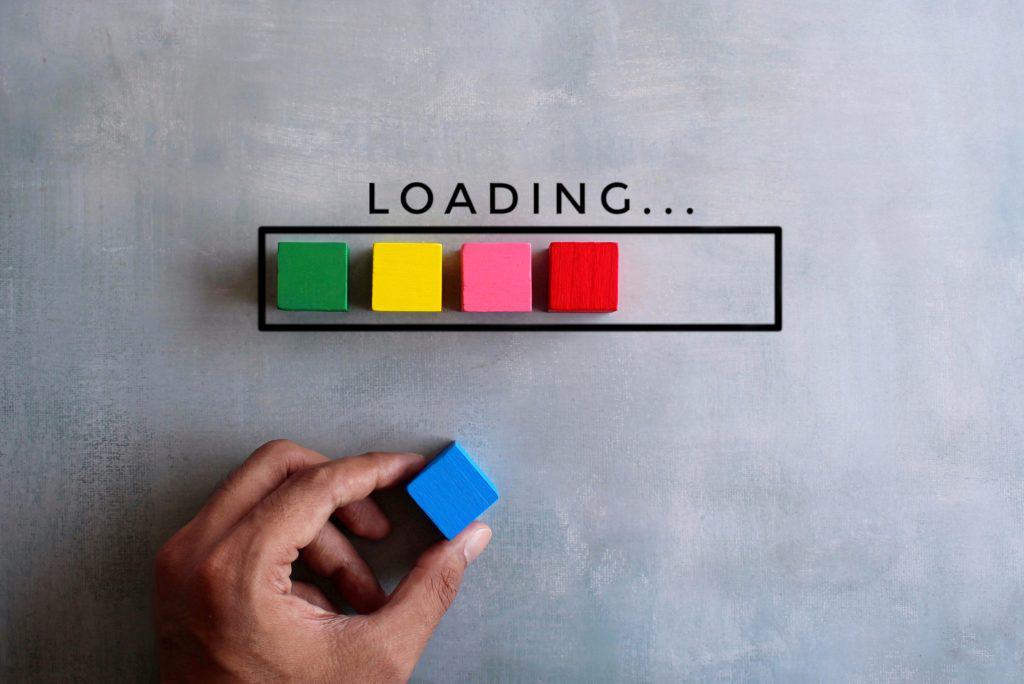Slow loading times mean lost sales, decreased conversions, and lower rankings. But why does it happen? And how do we fix it?
We’ll walk you through the most common causes of why a website is loading slowly and explain exactly what each means. Then we’ll share with you simple fixes that will make your site load faster and increase your conversion rates.

Why is a fast loading time important?
It’s no secret: people hate waiting. A recent study found that users are more likely to abandon a page if it takes longer than 3 seconds to load. That’s because they feel like their time is being wasted by the website.
And when visitors leave a page before completing an action, they’re less likely to return. So, having a fast-loading website can help improve your SEO, boost your conversion rate, and keep customers on your site for longer.
What are the reasons why a website is loading slowly?

There are many reasons why a website might be taking too long to load. Here are some of the most common culprits:
1. Too Many Images
Images are one of the most common culprits behind slow web pages. If you have too many images on your site, it can cause your site to load slower.
For example, if you have 10 images on a single page, each image takes longer to download than a normal webpage.
This is especially true if those images are big files such as jpgs or pngs.
This becomes more of an issue when the images are not optimized. For example, if you use large file sizes and low quality JPEGs, your site may take much longer to load.
2. Poorly Optimized Code
Poorly optimized code can also lead to slow webpages. For example, if you have poorly written HTML code, it can affect the performance of your site.
HTML code is used to format text and display information on a web page.
It’s important to write clean, readable code. Otherwise, your site will perform poorly.
3. Large Files
Large files can also impact the speed of a website.
A file is anything that contains content, such as an image, video, PDF document, or spreadsheet.
These types of files can weigh down your site and slow its performance.
4. Bad Caching
Caching refers to storing previously downloaded files on your computer.
When you visit certain websites, your browser stores these files locally on your computer.
Then, when you return to that same website later, your browser uses the cached version instead of downloading it again.
Unfortunately, caching doesn’t always go smoothly. Sometimes, your browser won’t cache the right files, causing your site to load slower than expected.
5. Server Issues
Server response times refer to the time between when a visitor clicks a link on a website and when the requested resource appears on screen.
A fast server responds quickly to client requests, allowing visitors to navigate your site smoothly.
Slow servers respond slowly, causing visitors to wait longer before seeing content. This makes visitors feel impatient and frustrated, and it can lead to abandonment.
6. Malware Infections
Malicious software, known as malware, can also cause slow web pages.
Some malicious programs can steal personal information, spy on user activity, or redirect visitors to phishing sites.
To avoid this type of infection, install antivirus software on your computer.
7. Heavy Traffic
Heavy traffic can also result in slow webpages.
As mentioned earlier, your computer sends data to and from your browser and the server.
If your network is busy, it can delay the transfer of data.
This can cause your site to appear sluggish.
8. Too Many Requests
Too many requests can slow down a website because they increase the number of HTTP requests.
HTTP requests are the messages that transfer data between a browser and a server. Each message carries a small payload of data.
The larger the payload, the greater the number of HTTP requests needed to transmit the data.
9. Bad Hosting Plan
Hosting plans differ based on the type of hosting service you choose. Some services offer free accounts, while others charge monthly fees.
Free hosting plans typically provide limited resources. These limitations include disk space, bandwidth, CPU power, and RAM memory.
In addition, free hosting plans often lack advanced features such as caching, CDN, SSL certificates, and email support.
10. Poorly Maintained Database
Maintaining a database requires regular maintenance. Regular maintenance ensures that your database runs smoothly and efficiently.
Unfortunately, many people neglect to perform regular maintenance on their databases. As a result, outdated information can accumulate over time.
This accumulation can negatively affect your website’s performance.
How can website loading time be improved?
Website speed has become an increasingly important factor in determining whether visitors leave your site or return again.
We’ll discuss how you can improve your website loading time.

1. Reduce Image Size
Images are the most common cause of slow page loading times. Images are heavy files that take longer to download.
So, first thing’s first – reduce image size. This means reducing the number of images on your pages, and using smaller images instead.
For example, if you have a photo gallery, you can resize each image to 200 pixels wide and 300 pixels tall. That will save you bandwidth and allow your users to view the images without waiting too long.
2. Remove Unnecessary Scripts
Scripts add unnecessary bloat to your page load times. To avoid slowing down your site, remove any scripts that aren’t necessary.
For example, if you don’t plan on using analytics, you should disable it.
3. Use Responsive Web Design
Responsive web design allows your website to adapt to any device. This means that no matter what size screen your visitors are using, your content will display properly.
This is especially helpful for mobile devices, since most websites don’t automatically adjust to fit smaller screens.
For example, if you have a photo gallery on your website, it won’t necessarily scale down to fit the width of a smartphone screen.
Instead, responsive web design makes sure that the image stays the same size regardless of the browser window.
It’s a win-win situation for everyone involved. Users get a faster browsing experience, and you get to save bandwidth and server resources.
4. Improve Server Performance
Server performance refers to the ability of your server to handle traffic. Servers are often overwhelmed by heavy traffic, causing delays and poor performance.
Improving server performance requires adding resources such as memory, CPU cores, disk space, and network bandwidth.
5. Avoid Using Flash
Flash is notorious for causing slow website loads. Although Flash offers several benefits, it is often difficult to implement correctly.
It is recommended that you avoid using Flash altogether.
In addition, if you decide to use Flash, ensure that you combine it with a CDN.
6. Reduce Page Size
A page is the smallest unit of content that can be displayed on a single screen. Pages usually include HTML code, CSS code, JavaScript code, and images.
Pages are often used to display static content such as text, graphics, videos, and audio files.
Pages are typically loaded using HTTP requests. Each request takes time to complete.
Reducing the number of pages on your site reduces the amount of time it takes to load those pages.
To reduce page size, remove unnecessary elements from your site. For example, don’t add unnecessary scripts or stylesheets to your pages.
Use CSS instead of inline style sheets. And avoid adding too much content to individual pages.
Instead, group related content together on a single page.
For example, if you sell products, group similar items together on a single page rather than displaying them individually.
This will allow users to easily navigate your site.
7. Update Your Site Frequently
Updating your site regularly improves its overall performance.
Regular updates ensure that your site stays current.
New features and improvements make your site more attractive to potential customers.
Also, regular updates keep your site safe from hackers.
8. Avoid Large Media Files
Large media files refer to large images, video clips, audio files, and other multimedia content. Because of their large size, these files take longer to transmit across the Internet.
A typical 1MB image file would take about 20 seconds to upload to a 3G connection. A 10MB video clip would take about 2 minutes to upload.
These delays can make your site seem sluggish and unresponsive.
You can minimize the impact of large media files by hosting them on a CDN (content delivery network).
CDNs provide servers located around the world. By placing your large media files on these servers, you can increase the likelihood that your visitors will receive the files quickly.
9. Keep Your Site Secure
Security is a major concern for anyone who runs a business online. Hackers constantly try to break into websites, stealing sensitive information and damaging the reputation of businesses.
One way hackers gain unauthorized access to your site is through cross-site scripting attacks. Cross-site scripting occurs when an attacker injects malicious code into a legitimate website.
If a hacker manages to insert malicious code into your site, they could steal personal information, redirect users to phishing sites, or even install malware on their own computers.
Cross-site scripting attacks are difficult to detect, making it critical that you keep your site secure.
Conclusion
In conclusion, slow website load times are frustrating for both users and webmasters alike. But if you’re wondering why your site is loading slowly, above are some common causes and solutions. Try to keep in mind these causes and solutions and use them in your website to achieve better results.



